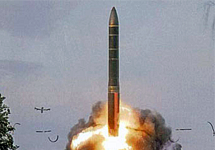Nikolai Sokov
February 28, 2014
Over the last several months, press reports have surfaced alleging Russia is violating the 1987 Intermediate-Range Nuclear Forces (INF) Treaty that bans nuclear missiles with ranges between 500 and 5,500 kilometers. The State Department has revealed that administration officials have pressed Moscow to resolve these concerns. However, the substance of the allegations as well as relevant technical and legal assessments remain opaque. The issue of these possible violations are complicated by a lack of solid information: most details are classified and leaked information is notoriously unreliable.
A Tale of Two Missile Tests?

ICBM Test Launch, Wikimedia Commons
The issues at hand resolve around two separate allegations. The first stems from Russia’s testing of the new Yars intercontinental-range ballistic missile (ICBM) launched from the Kapustin Yar testing range to another testing range, Sary Shagan (the tests apparently took place in 2011 and 2012). While the missile was reported to have flown less than the INF Treaty’s upper range (5,500 km), the system has a demonstrated range above that and thus falls under the New START Treaty as a strategic missile. Existing treaties do not prohibit flights to a distance shorter than a missile’s maximum range, and thus the system would not represent a violation of the INF agreement. Such systems can be a cause of concern from a stability or deterrent perspective, but that is not the same as a treaty violation.
A potentially more serious alleged violation involves a reported test of a ground-launched cruise missile to an intermediate range. Very little reliable information has been publicly revealed about that missile system. Attention has so far focused on the R-500 ground-launched cruise missile, which Russia developed for the Iskander system (it can be equipped with both ballistic and cruise missiles). Under treaties, this system was declared by Moscow as having a range just below 500 kilometers and thus not subject to the INF Treaty. It has long been rumored, however, that R-500 has the capability to fly at longer ranges, in which case it would constitute a violation of the 1987 treaty. Apparently, there have been suspicious tests, but it is difficult to judge how conclusive the data is given the State Department’s reluctance to classify it as an outright violation.
A Plausible Alternative
The uncertainty of available information allows for multiple interpretations. One intriguing possibility is that the two allegations may actually reflect different interpretations of the same Russian test(s).
The flight test(s) in question was part of a Russian program to develop the capability to penetrate future U.S missile defenses. One of the elements of this effort is a a gliding, maneuverable reentry vehicle (RV), begun in the last years of the Soviet Union, shelved for financial reasons, and subsequently resurrected. This RV was flight tested for the first time in 2005 and was dubbed by open sources as the Igla (Russian for needle). After that first, successful test it once again disappeared from public eye, although work has undoubtedly continued.
Igla is a rather large RV that can fly at high speed after being released from a ballistic missile (available information suggests that Yars or its modification, Yars-M will be the carrier). The system can reportedly perform a series of maneuvers in two dimensions (right and left as well as up and down). These maneuvers make interception of the RV very difficult; Russian experts claim that even impossible under existing or near-term technologies.
Launches of ballistic missiles with the gliding RV to Sary Shagan, a former Soviet-time test range that specializes in missile defense systems, can cause suspicions due to their circumstances. Given the (relatively) short distance between Kapustin Yar and Sary Shagan, a test involving the Igla RV would have required early release of the RV, making the range of the missile itself quite short. After the release, Igla traveled a non-ballistic trajectory maneuvering along the way and covering a significant distance, perhaps 1,000-2,000 km. In this way it might resemble a cruise missile if monitored by national technical means (such as satellites). This scenario, indeed, allows for a significant degree of uncertainty of interpretation of data.
In the past, details of such test(s) could have been acquired from telemetry data supplied by Russia, but New START provides for the exchange of telemetry on only some tests. Russia, as is its right under New START, has chosen to refrain from providing telemetry on tests of new advanced systems, especially those designed to defeat US missile defenses. National technical means, in contrast, might find it difficult to yield conclusive information.
While there is no firm evidence to prove the interpretation of events offered here is correct, it remains unclear that other scenarios have more validity. We do not really know which launch(es) the United States tracked – that of Igla or the cruise missile for Iskander. We do not know what made that alleged cruise missile test suspicious – an actual flight test or its size, which might seem too big for a short-range system.
Don’t Let Facts Get in the Way of a Good Argument
The lack of hard data may has given opponents of negotiated nuclear arms reductions in the United States an opening to question efforts to conclude new treaties. If true, Russian violations would be rightly a concern and require the United States to determine if they pose any kind of militarily significance. However, the scenario discussed above also merits consideration and those who might rush to judgment might be well served to consider these other plausible alternatives.
It would be advisable to give experts time to thoroughly discuss these issues in the special bilateral forum without undue interference of politics. The United States needs to press Moscow to disclose relevant information on the cases of concern so that future decisions with regard to implementation of New START and INF as well as on the next steps in nuclear arms reductions proceed from solid factual base instead of political noise.
